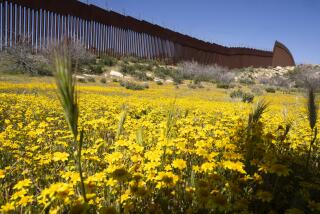Mexico Moves to Preserve Monarchs’ Winter Home
- Share via
SIERRA CHINCUA, Mexico — The government has proclaimed a reserve in the fir forests northwest of Mexico City to keep farmers from destroying trees on which the orange and black monarch butterflies shelter in winter.
Each year about 100 million of the huge, spectacularly beautiful butterflies make the journey of more than 3,000 miles from the eastern United States and southeastern Canada to the forests of oyamel fir in a mysterious migration unique among insects.
Man has become the main threat to their winter home because the forests along the border between Michoacan and Mexico states are a major source of income for farmers in the region.
Without government protection, lumbering and clearing for agriculture could destroy the habitat. Scientists are not sure whether the monarchs could adapt to other conditions.
‘Big Step Forward’
Declaration of the reserve “should be recognized as a big step forward that will allow future generations in the United States, Canada and Mexico to enjoy the beauty of the monarch and the spectacle of its migration,” said Curtis Freese, director of Latin American and Caribbean programs for the World Wildlife Fund.
He called the action by President Miguel de la Madrid’s administration one of the most significant steps in defense of the monarch.
Freese spoke during a ceremony to announce the decree, held Aug. 22 just outside an area where the monarchs form winter colonies. It must be published in the federal register to have legal effect.
Few Natural Enemies
The World Wildlife Fund has provided an average of $30,000 to $40,000 annually in the past five years for scientific research on the monarchs--Danaus plexippus--and to develop Monarca, a private Mexican organization to protect them.
Monarchs, which are big enough to fill the palm of a man’s hand, have few natural enemies. Eating them makes most birds sick, but mice and two species of birds do prey on them.
“Paradoxically, their worst enemy is man, who provokes their death by destroying the habitat of the species, which is the forest, a natural cushion that buffers winds and abrupt temperature changes,” said a statement issued at the Friday ceremony by the government’s Urban Development and Ecology Department.
Two-Month Journey
Butterflies born at the end of summer in North America migrate, arriving around Nov. 1. It takes them about two months to reach their winter haven from the northernmost sites.
They colonize only during the wintering period, covering the towering oyamel like another layer of bark when the air is cold, showing the tan undersides of their folded wings.
Monarchs cannot fly at temperatures below 59 degrees and they begin to freeze at 25 degrees, but when warmed by the sun they fill the air in a blizzard of bright orange.
Ecologist William Calvert of Austin, Tex., a leading researcher, has found that thinning of the forest lowers the nighttime temperature and a drop during storms or cold waves of even one-tenth of a degree can kill thousands of the butterflies.
1975 Discovery
The monarch colonies were known only to local farmers until Canadian zoologist Fred A. Urquhart found them in 1975.
Rodolfo Ogarrio, a lawyer who heads Monarca, noted that creation of the reserve was announced 10 years after the August, 1976 National Geographic article that made Urquhart’s discovery public.
More to Read
Sign up for Essential California
The most important California stories and recommendations in your inbox every morning.
You may occasionally receive promotional content from the Los Angeles Times.













